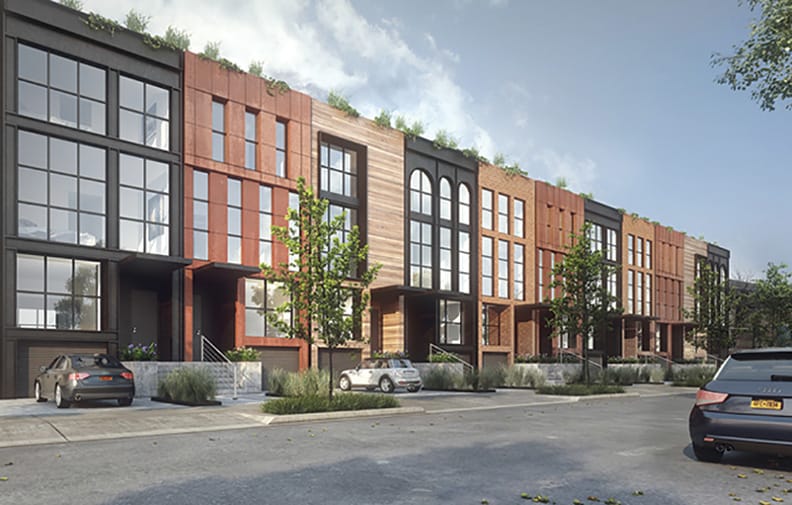Red Hook is undergoing a renaissance. At least according to a recent The Real Deal article that sees the accelerated growth in market rate housing and commercial construction as “livening up this remote Brooklyn community.”

Such “livening up,” however, is often accompanied by diminished affordability and displacement, disproportionately affecting working class families and people of color. Already, 48% of Red Hook residents are rent burdened, renters that – as outlined by U.S Department of Housing and Urban Development – devote more than a third of their income to housing.
With 160 Imlay Street, the BASIS School, and Est4te Four’s 1.1 million square foot waterfront office project on the horizon, the question of how to ensure Red Hook doesn’t become another case study of gentrification carries increasing urgency.
Red Hook is not alone in experiencing a crisis of affordability as the mismatch of stagnating wages and rising rents has left more than half of the city’s renters rent burdened. Amidst this backdrop, Mayor de Blasio’s “Housing New York” plan has brought some hope that a progressive housing policy can reverse some of these trends.
While the reach of de Blasio’s Plan – cited as the most ambitious municipal housing initiative in American history – is commendable, its reliance on traditional affordable housing mechanisms may fail to generate the long-term affordability that many New Yorkers need.
The prevailing model of affordable housing development – utilizing public money and tax abatements to incentivize private developers to include affordable units – is hardly accessible to New Yorkers that need it most. The formula the city uses to determine affordability, Area Median Income, standing now at $85,900 for a family of four, makes many of these “affordable” units created on the private market out of reach for low income neighborhoods and households.
The shortcomings of traditional affordable housing development measures are forcing advocates, community organizations, and policy makers to seek a new blueprint that creates real affordability. One model gaining increasing visibility and momentum is the community land trust (CLT).
With roots in the 1960’s civil rights movement when organizers worked to provide land ownership opportunities to African American farmers, the CLT model is being revived as a mechanism to create permanent affordable housing in low-income neighborhoods.
At its core, a CLT removes housing from the speculative market by separating the ownership of property from the ownership of the land. The owner of the land is often a nonprofit, community-based organization that retains ownership of the parcels in perpetuity. Buildings on CLT land can range from single-family homes, rental buildings, condos, co-ops, to commercial spaces. Currently there are over 200 CLTs across the country, including several that can serve as templates for application in Red Hook.
Founded in 1959, the Cooper Square Community Land Trust has housed generations of low-income families in the Lower East Side through a combination of CLT, Mutual Housing, and Limited Equity Cooperative models. The Dudley Street Neighborhood Initiative, granted the power of eminent domain in 1984, repurposes abandoned properties and provides permanent affordability in one of Boston’s most disinvested communities. In San Francisco, over 21 households filled with families and senior citizens were preserved after a decade-long organizing campaign led by the San Francisco Community Land Trust. These are just a few examples proving the feasibility of community ownership models to counterbalance displacement pressure and ensure long lasting affordability.
Given this backdrop of crisis and opportunity, a coalition of non-profits, housing developers, academics, community residents, and local elected officials convened to form the New York City Community Land Trust Initiative (NYCCLI). The Initiative, of which the local community based Carroll Gardens Association (CGA) recently became a member, fights to “preserve the right of extremely low income people to live in the city by supporting Community Land Trusts and other community-led housing and neighborhood development” through technical support, research, popular education, grassroots organizing, and advocacy.
NYCCLI has four working groups including Education and Outreach; Legislation, which is defining a CLT legislative and policy agenda; Governance, which is developing the governing structure framework for equitable and sustainable CLTs; and a pilot project group, that is actively working to implement a CLT in East Harlem. This multi-pronged approach aims to lay the foundation for a citywide alliance spearheading community driven neighborhood planning.
With a progressive councilmember committed to innovative policy initiatives, a strong network of community based nonprofits, and rich history of resident led grassroots organizing, Red Hook already possesses the foundation to implement Southwest Brooklyn’s first community land trust. Left unchecked, the growing specter of real estate speculation will transform Red Hook into another enclave of gentrification.
Community Land Trusts are a proven model that can counterbalance displacement while providing affordability for generations to come.








